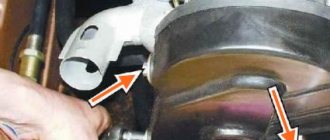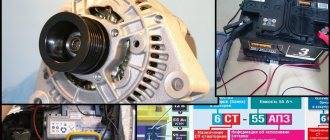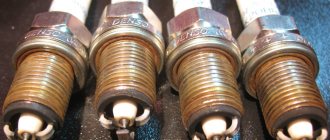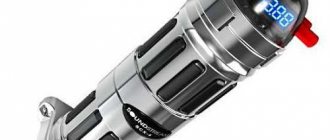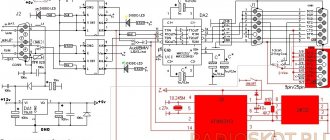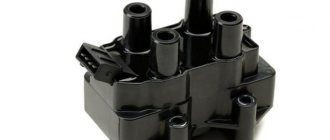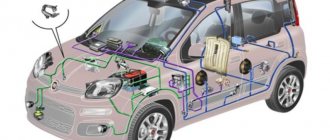As you know, the year of a car can be found out from the data in the title and registration certificate. But few people know that the year can also be determined by the accompanying units and markings on car windows, seat belts, etc.
It is important to remember the main thing, sometimes at the factory itself they can install glass from last year’s batch and, accordingly, the year on the glass will be, for example, 2010, and the car will be 2011 - this is normal. But if your car's glass is older than 2014, for example, and your car is 2013, then you should think about whether your car was in an accident.
The year marking on the glass is to some extent encrypted and it is difficult for the average car owner to decipher this “cipher” and calculate the year of the car on the glass. In this article we will take a closer look at how to find out the year and even month of glass production. Thus, when inspecting the car for sale, no one will mislead you by trying to hide the real age of the used car from you.
Typically, car glass markings are located in one of the lower corners. As an example, consider the factory stamp shown in the figure.
Now, in order: Number 1 - designation of the type of automobile glass. Digit 2 is the code of the country that grants approval. Number 3 – compliance with UNECE requirements. Number 4 indicates the year and month of glass production. Number 5 is the sign of the manufacturer.
As you probably already guessed, we will especially need to disassemble the lower part of this stamp (symbols indicated by the number 4). In this example, the number "14" represents the last two digits of the year of manufacture. That is, this car was produced in 2014. But please note that not all manufacturers can indicate two digits in the release date. Some are limited to just one. For example, if on the glass you are looking at, instead of the number “14” there is one digit, for example “0”, then it is the last, fourth digit of the year of manufacture. Therefore, this car was released either in 2000, or in 2010, and maybe even in 1990.
In this case, its model will help you determine the year of manufacture of the car by looking at the glass. Let's say a manufacturing plant began producing a certain car model in 2005. Therefore, if we see the number “0” on the glass stamp, then this cannot in any way mean the year of manufacture 2000, and, especially, 1990. Most likely, this car was produced in 2010. Or let's take another example - a more specific one. Let’s assume that the marking also contains only one number, for example “4”. The make of this car is VAZ 2112. Even if you are not very knowledgeable about cars, then by searching for information on the Internet, you can find out that the VAZ 2112 was produced by the car plant from 1999 to 2008. Therefore, the number “4” can only indicate one version of the year of manufacture - 2004, and not 1994 or 2014, since this car was simply not produced in those years! As you can see, everything is quite simple.
Of course, there are rare exceptions when a certain car brand has been produced for more than 10 years. Such cars include, for example, the Niva from VAZ. In such cases, to find out the year of the car, you need to pay attention not only to the markings on the windows, but also to the external condition, for example, the presence of corrosion, scratches, dents and other features of the used car. Be that as it may, I think many will be able to distinguish a relatively new car from one that was released more than ten years ago.
Well, now let's try to figure out the month the car was produced. Determining it is a little more difficult, but also quite realistic. Near the numbers indicating the year of manufacture there is a certain number of dots (see figure). It is from them that we will now learn to determine the month. The diagram below shows how this can be done:
14 (six dots, then a year) - month January. . . . . 14 (five dots, then a year) - the month of February. . . . 14 (four dots, then a year) - the month of March. . . 14 (three dots, then a year) - the month of April. . 14 (two dots, then a year) - the month of May. 14 (one point, then a year) - month June 14. (first the year, then one dot) - month July 14. . (first the year, then two dots) - the month of August 14. . . (first the year, then three dots) - month September 14. . . . (first the year, then four dots) - month October 14. . . . . (first the year, then five dots) - month November 14. . . . . . (first the year, then six dots) - the month of December.
As can be seen from this diagram, if the dots are located before the numbers, then this is the first half of the year, but if after the numbers, then the second. Now, having looked knowledgeably at the above figure, we will understand that this car was released in February 2014.
And finally, I would like to draw your attention to some non-standard situations. It happens that a used car has previously been in an accident, or for other reasons one or two windows were once broken. And since the damaged glass was replaced, the markings on the glass themselves may differ. In this case, it is recommended to pay attention not to one, but to all the windows of the car in order to have a complete picture of it.
If, for some reason, the stamp on the glass is missing or simply worn out, then it will no longer be possible to determine the age of the car using this method; you will have to do this in another accessible way.
Of course, everyone who wants to buy a car wants it to be not very old. The younger your car, the longer it will last and, accordingly, vice versa, the older, the less. You can determine the production and release date of your car if you look at the entry in the technical passport for this car or try to decipher the identification number (body number).
It is not at all difficult to determine the production number of a car by the markings that are applied to the window glass of the car. The name of the manufacturer's company, compliance standards are displayed there, the month and year of glass production are indicated. Basically, the year of production is indicated by one digit, which is the last one in the calendar, and the month is indicated by dots and this date appears before the beginning of the year designation. This is the simplest way to determine the month of manufacture of a car.
It happens that a fraction symbol is used in the date of manufacture of glass. Each of the inclined fractions represents five months and appears on glass markings that are issued starting from the month of May. In general, in a car you can find many marked parts, from the markings of which you can determine the date of manufacture, and the time from the start of mass production to the warehouse is about six months, after which you yourself can determine the time when your car was born.
The date of manufacture of the car must be clearly indicated in all documents for the car itself. But there are situations when it is not easy to determine the date of production and release, for example, when there are no relevant documents for the car. You also need to find out the exact month the car was manufactured; this is very important for crossing the border.
The production date can be determined by the numbers of the main components of the car and its parts: gearbox, engine, chassis. There is also a proprietary method that allows you to determine the release date; it was developed by the vehicle manufacturers themselves. There are also rules: for the month of issue, the exact date is the fifteenth, and if you could only find out the year of issue, then the first of July of that year is generally taken as the date.
Remember, only the manufacturer of this car or a regional representative of the company can accurately determine the date of production and release using the known spare part numbers of a car. It is within his competence how to find out the month of manufacture of the car. There are also certain situations when it is impossible to determine the date of release of the car and then you need to turn to specialized examination, which is carried out in customs laboratories or licensed organizations.
When buying a used car, it is very important to find out exactly the year of its production. There are several ways you can find out what year a car was produced.
The easiest way is to look at the technical data sheet
car. If the owner constantly used his vehicle and underwent technical inspections on time, then you can completely trust the passport. The year of production is also indicated in the OSAGO and CASCO policies.
However, there are often situations when there are simply no documents for a car, for example, if the car has been sitting in a garage for a long time or it was imported from abroad. In this case, you should resort to other methods of determining the year of production.
VIN code
The VIN is a 17-character plate that is usually located under the hood or on the cross member under the front bumper. In any case, the seller must show you the VIN code; you can use it to get a lot of useful information about the car; the production date is the tenth character.
You should navigate this way:
- The years 1971 to 1979 and 2001 to 2009 are indicated by numbers 1-9;
- Years from 1980 to 2000 are indicated by the letters A, B, C and up to Y (the letters I, O, Q, U, Z are not used for marking).
It is worth noting that this is how the model year of manufacture is indicated. Many manufacturers use their own designation system, for example, the American division of Ford encrypts the exact year and month of manufacture of the car in the 11th and 12th positions of the Vin code, while Renault, Mercedes, Toyota do not indicate the year of manufacture at all and can only be determined using plates on the body.
There are many resources on the Internet that can help you decipher the VIN code; with their help you will find out not only the production date, but also the country, engine type, equipment, and so on.
If the car was registered and operated in Russia, then the VIN code must be in the traffic police database. If the code is interrupted, then everything is not going smoothly with this machine.
how to find out the year of manufacture of a car, ways to determine the date of manufacture of a car
Before concluding a purchase and sale agreement for a used car, it is important to find out the production date of the car. This procedure will help to identify attempts at deception on the part of the seller of the vehicle and draw a conclusion about the rationality of the intended purchase. Today “Autocode” will tell you about the methods by which you can determine when a car was produced.
What does the VIN code tell you?
Most vehicles have a VIN - a special identification code consisting of 17 characters (numbers and letters). It contains information about the manufacturer and release date of the car. Most often, the year of manufacture of the vehicle is located in the 10th position of the VIN code. It is important to know that the methods of marking the production date of vehicles have changed over different periods.
Including:
- from 1980 to 2000 and, since 2010, the letters of the Latin alphabet from A to Y are used for this, with the exception of the letters I, O, Q, U and Z
- from 1971 to 1979 and from 2001 to 2009. the production date of the cars had a digital designation.
Please note that the VIN contains only the last digit of the year number. For example, the Latin A denotes cars of both 1980 and 2010, the number 4 – 1974 and 2004, etc.
Some automakers use their own labeling system. For example, in the United States, on Ford cars, the production date of the car is located in positions 11 and 12 of the VIN. It also includes the month of production. And vehicles from Japan do not have a VIN code at all.
In addition, when checking a car, you need to know that most manufacturers indicate in the VIN code information about the so-called model year of the car. It starts not on January 1, but on July 1. Therefore, the VIN code data may not correspond to the calendar we are used to.
From all of the above, it is clear that it is not so easy to independently find out the year of manufacture of a car by VIN. Therefore, it is better to use a trusted online resource to check the vehicle.
How to find out the year of manufacture of a car online
A simple and reliable way to find out the year of manufacture by wine or state. car number – use the Autocode service. Enter the VIN or state registration number of the car into a special search form. Within a few minutes, the system will issue a report with information about the year of manufacture of the car and other useful information. In particular about:
- number of vehicle owners;
- mileage;
- road accident;
- the presence of restrictions (pledge, arrest, etc.) and other data important for making a purchase decision.
The cost of a detailed report is 349 rubles.
How to find out the year of manufacture of a car by marking components
Various parts and mechanisms of the car also carry information about the production date. Let's consider how to find out such information.
Glass
You can find out the month and year of manufacture of the car by the stamps on the windows. Auto glass manufacturers use different branding methods. The year of manufacture is indicated by one digit, which corresponds to the last digit of the calendar year (similar to VIN).
Thus, the number “6” can mean 1996, 2006, or 2016. Next you need to be guided by logic. For example, if you know that a given vehicle model was produced from 1998 to 2010. – accordingly, the number “6” will mean the year of manufacture 2006.
The month is indicated by Latin letters (from A to M in alphabetical order) or combinations of dots and (or) slashes.
For clarity, here are a few examples:
- ….6 or 6…. – April 1996, 2006 or 2020;
- 9 ABC or ABC 9 – January 1989, 1999 or 2009 (only the first letter of the three is taken into account).
There are exceptions to the rules. For example, on the windows of Fiat cars, January is indicated by the letter “B”. Accordingly, the designation system is shifted by one position, and December is no longer branded “M”, but “N”.
When determining the production date of a car, it is important to check all the windows. If you find that the markings of individual elements do not match, ask the seller whether the vehicle was involved in an accident, which caused the replacement of one or more glasses.
Safety belt
The date of manufacture of the vehicle is stamped on a label attached to the bottom of each seat belt. Belt fasteners also have similar markings. The designations are simple: day, month and year of issue. Therefore, it will be easy to understand them.
Shock absorber struts on hoods and trunk
Since the mid-90s of the 20th century, on cars from Europe, these components also have markings that make it easy to determine when the car was manufactured. The year of manufacture is indicated in two ways:
- 25/98 (where the first digit is the serial number of the week from 1 to 52, and the second is the year);
- 318/95 (where the first digit is the serial number of the day from 1 to 365, and the second is the year).
Similar markings can be applied to the battery terminals, as well as to the muffler.
The discrepancy between the data on individual components and the production date indicated in the vehicle registration certificate is a good reason to think about the advisability of purchasing it. Often, buyers are faced with the fact that “original” parts have been replaced with new ones for one reason or another. It is impossible to find out exactly the release date of a car from them. Therefore, we still recommend using the all-Russian service “Autocode” for checking.
Source: https://avtocod.ru/kak-uznat-god-vypuska-avtomobilya
Other ways to determine the production date of a car
- On the seat belts at the very bottom there is a label with the year of manufacture; it is clear that this method is only valid for new cars and those in which the belts have not been changed;
- There should be a plate on the bottom of the front passenger seat indicating the production date, if the owner allows you to remove the seat, you can check;
- The windshield has a production date on it; if it has not been changed, the dates will match.
Typically, sellers have no reason to hide the real release date of a car, but if they refuse to provide you with the necessary information, there is reason to wonder whether you are buying a pig in a poke.
| Question | Answer |
| · decryption through special services; · independent decoding; · sending a request to the manufacturer. | |
| The actual year of manufacture of the vehicle. | |
| Belonging to a specific car model or its restyling for a specific year. | |
| · full name of the vehicle; · manufacturer; · model year; · exact date of manufacture; · information about the power unit and transmission; · factory color and other characteristics. | |
| partsfan.com; · pogazam.ru/vin; · avtoraport.ru. |
The year of manufacture of the vehicle affects the cost of customs clearance when importing a car from abroad (the younger the car, the higher the price), and also helps to choose the right part if the vehicle breaks down. The vehicle's production date can be determined by its VIN number.
There are several ways to find out the production date of a car using the vehicle's VIN code:
- Independent decoding. In most cases, the body identification number contains information about the year of manufacture of the car. It is important to understand that if you decrypt it yourself, you can only find out the year, without indicating the date and month.
- Decryption using specialized services. Online resources allow you to find out all the basic information about a car: make and model, exact release date, manufacturer, engine type, etc. In some cases, services provide services on a paid basis.
- Sending a request to the manufacturer. The cost of the service is paid, the amount depends on the company. If necessary, you can make a request through an official representative (dealer).
Year of manufacture on the car glass
Almost every car glass contains information about the year of its manufacture. You just need to be able to find it and interpret it correctly.
Typically, the information stamp is located in one of the lower corners of the car window.
Consider the example shown in the figure on the left.
In this case, we are only interested in the lower part of the information stamp, namely the line “0. . ."
Number in this line
- this is the last digit of the year in which the car was produced. In this example, the number 0 means that the car was produced in 2010.
However, I would like to draw your attention to the fact that in practice the number 0 means both 2010 and 2000, 1990, etc. To determine the exact year, you need to have some information about a specific car model.
For example, look at the picture at the beginning of this article. On it you can see that the last digit of the year of manufacture of the car is 4. This photo was taken on a VAZ 2112 car, which was produced from 1999 to 2008. Obviously, the model year of the car in the example is 2004.
I note that only a few cars are produced unchanged for more than 10 years. For example, these include the VAZ 2107 and Niva. However, in practice, as a rule, it is not difficult to distinguish a new car from a car that was 10 years old. On an older car, rust usually appears, there are a large number of dents and other body defects.
Another secret of the car glass stamp
. In addition to the year of manufacture of the glass, it also contains the month of manufacture, but it is a little more difficult to determine. The month is encrypted in the number of dots next to the year number. Namely:
0 - January 2010. . . . . . 0 - February 2010. . . . . 0 - March 2010. . . . 0 - April 2010. . . 0 - May 2010. . 0 - June 2010. 0 . — July 2010. 0 . . — August 2010. 0 . . . — September 2010. 0 . . . . - October 2010. 0 . . . . . - November 2010. 0 . . . . . . - December 2010.
Please note that the three dots to the left of the year are April, and the three dots to the right of the year are September. Nothing complicated.
Using this diagram, you can easily determine that in the first example of this article we are talking about February 2004, and in the second - about September 2010.
Using this method you can find out the year of manufacture of almost any car.
However, I want to note some features that need to be taken into account
:
1. If one of the car windows has been replaced, then its year of manufacture will be different from the rest. Therefore, for greater accuracy, I recommend inspecting all vehicle windows.
2. Some cars produced at the beginning of the year may have different windows from different years. For example, a car manufactured in January 2014 may have some glass from 2013. This is fine.
3. On some new cars, not one, but two last digits of the year of manufacture are indicated on the glass.
4. On some glasses, information stamps may be erased or completely absent. In this case, the year of manufacture of the car cannot be determined.
Car enthusiasts are well aware that any vehicle, be it a car, motorcycle or trailer, has. In English, Vehicle Identification Number literally translates as “Car Identification Number”. VIN is compiled based on international standards.
There are only two of these: ISO 3779-1983; ISO 3780.
The numbers are entered into places regulated by the manufacturer, and the number itself consists of 17 characters. The first three signs are tied to the place of production (the first sign is the continent, the second is the country, the third is the plant). The following six characters describe the characteristics and features of the car - engine size, body type, equipment, etc. Next are the numbers and signs of VIS, in English – Vehicle Identification Section (“Vehicle Identification Section”). It is in this section that the code for the year of manufacture of the vehicle is encrypted.
How to decipher the year of manufacture
You can find out the year of manufacture of a car by VIN code by reading the 10th character of the identification number. This applies to manufacturers from Northern Europe, America and some Asian countries that adhere to the international standard for compiling the VIN code ISO 3779-1983. The following designations are assigned by year:
| Year | Designation | Year | Designation | Year | Designation | Year | Designation |
| 1971 | 1 | 83 | D | 95 | S | 07 | 7 |
| -72 | 2 | 84 | E | 96 | T | 08 | 8 |
| -73 | 3 | 85 | F | 97 | V | 09 | 9 |
| -74 | 4 | 86 | G | 98 | W | 2010 | A |
| -75 | 5 | 87 | N | 99 | X | 11 | IN |
| -76 | 6 | 88 | J | 2000 | Y | 12 | WITH |
| -77 | 7 | 89 | TO | 01 | 1 | 13 | D |
| -78 | 8 | 1990 | L | 02 | 2 | 14 | E |
| -79 | 9 | 91 | M | 03 | 3 | 15 | F |
| 1980 | A | 92 | N | 04 | 4 | 16 | G |
| -81 | IN | 93 | R | 05 | 5 | 17 | N |
| -82 | WITH | 94 | R | 06 | 6 | 18 | J |
Based on the table, the designations are repeated every 30 years. At the same time, manufacturers do not use the number 0, as well as the letters I, O, Q, since there is a possibility of confusing these characters.
Year of manufacture of the car by VIN code
So, how can you find out the year of manufacture using the VIN code? The 10th or 11th digit is used to identify the year of manufacture in the VIN. The first option is used by most automobile concerns in Asia, Europe and some North American concerns. The 11th character determines the year of manufacture in accordance with the traditions of the US automotive industry. Note that the European subsidiaries of Ford, originally an American company, also use the eleventh character to determine the year of manufacture. Also, the Toyota, Mercedes Benz and Renault concerns do not identify the model year by VIN at all; it is stamped on the body on a special nameplate.
To better understand, here is an example of a car identification plate by year of manufacture since 2010:
- 2010 – A
- 2011 – B
- 2012–C
- 2013 – D
- 2014 – E
- 2015 – F
- 2016 – G
- 2017 – H
- 2018 – J
As you can see, the identification number is ordered in accordance with the Latin alphabet. Let us add that the license plates of cars from 2001 to 2009 have a digital sign from 1 to 9, respectively.
Exceptions
Japanese manufacturers adhere to their own standards for compiling the VIN code (chassis number) and they do not encode the year of manufacture of the car into it. The same applies to some other countries. To distinguish the international standard ISO 3779-1983, you should know that the identification number according to ISO 3779-1983 always consists of 17 characters and does not contain dashes. Also, in place of the 10th character there cannot be the number 0 and the letters I, O, Q. At the same time, the presence of the number 0 (but not the indicated letters) is allowed in other positions.
You can find out the year of manufacture of a vehicle whose VIN code does not comply with ISO 3779-1983 in three ways:
- Through specialized services. For example, on the website drom.ru via the link www.drom.ru/frameno you can find out the year of manufacture of Japanese cars manufactured up to 2010 inclusive.
Please note that in most cases, Honda and Suzuki cars are not checked by the online service due to the lack of the necessary database.
- Through a request to an official representative. The car owner can send a request to the dealer, who will forward it to the manufacturer. In this case, you will need to pay for the services of the dealer and the manufacturer.
- On the glass of the vehicle, where the year of its manufacture is always indicated. Please note that the glass on the car may have been replaced previously.
Why is it worth checking your car's history through Autocode?
All information presented in the reports is collected only from official sources - traffic police, EAISTO, RSA, Federal Tax Service, Federal Customs Service, Federal Tax Service and others.
What other advantages of checking through Autocode:
- If you do not have the opportunity to check the history of the car in advance, with the mobile application you can do this during the transaction.
- If you have any questions, you can contact support. The service staff will help you solve the problem and explain how to find out the year of manufacture by the car number.
To avoid becoming the “lucky” owner of an old car at the price of a new one, you need to check the car before purchasing. By ordering a report on Autocode, you will protect yourself from possible troubles and save your own money.
This is what the VIN code of the car looks like:
ZFA 223000 05556777
The VIN code (body number) of a car contains 17 characters, the VIN code includes three parts: WMI - 3 characters, VDS - 6 characters, VIS - 8 characters.
Decoding the 1st part of the VIN code
1 PART. WMI (World Manufacturers Identification) - literally repeated as “world manufacturer index”. WMI is a code that identifies the manufacturer of the vehicle. WMI consists of three characters:
The first character (geographic area code) is a letter or number that designates a specific geographic area. For example: from 1 to 5 - North America; from S to Z - Europe; from A to H - Africa; from J to R - Asia; 6.7 - Countries of Oceania; 8,9,0 - South America.
The second character (country code) is a letter or number that identifies the country in a specific geographic area. If necessary, multiple symbols may be used to indicate a country. Only the combination of the first and second character guarantees unambiguous identification of the country. For example:
* from 10 to 19 - USA; * from 1A to 1Z - USA; * from 2A to 2W - Canada; * from W0 to W9 - Germany, Federal Republic; * from WA to WZ - Germany, Federal Republic.
The third character is a letter or number that is set to a specific manufacturer. Thus, the combination of the first, second and third characters provides an unambiguous identification of the vehicle manufacturer - the international manufacturer identification code (WMI).
Note.
The number 9 may also be present as the third character. In this case, it characterizes a manufacturer that produces less than 500 cars per year. The production volumes of quite a few companies are measured in hundreds or even dozens of vehicles per year.
For such cases, and in order to save possible variants of the manufacturer's code (WMI), the standard for manufacturers with an annual volume of up to 500 cars provides an option when they are all combined under one WMI ending in “9”, and an additional code is entered in 12... 14 VIN positions. The remaining 3 characters at the end for the serial number are more than enough for such volumes. Example: all small German automakers put VIN on their products in the format W09xxxxxxxxYYYxxx, where W09 is a code indicating that the manufacturer belongs to Germany and the production volume is no more than 500 cars per year, YYY is a code indicating a specific manufacturer. Manufacturers fill out the remaining VIN positions at their discretion.
Decoding the 2nd part of the VIN code
PART 2. VDS (Vehicle Description Section) – descriptive part. The descriptive part of the identification number (VDS) consists of six characters (if the vehicle index consists of less than six characters, then zeros are placed in the empty spaces of the last VDS characters (on the right), indicating, as a rule, the model and modification of the vehicle, according to the design documentation ( KD). The 4th, 5th, 6th, 7th, 8th characters reveal the characteristics of the vehicle, such as body type, engine type, model, series, etc.
Body type, for example, for Toyota (4, 5 characters):
11 – Jeep/Minivan with standard roof 12 – Minivan with raised roof 21 – Truck bus with standard roof 22 – Truck bus with raised roof 23 – Truck bus with high roof 31 – Pickup truck / Truck with single cab 32 – Pickup truck / Truck with cab Cab 33 – Pickup / Double Cab Truck 41 – Standard Roof Bus 42 – Raised Roof Bus 43 – High Roof Bus 52 – Hatchback, 2 Side Doors 53 – Sedan 54 – Hatchback, 4 Side Doors 63 – Coupe 64 – Liftback 72 – Station wagon / carriage.
The 9th character is the check digit of the VIN number, which is used to check its correctness (how to check the VIN for correctness -).
What is the difference between model and calendar year
The calendar year is the actual year of manufacture of the vehicle. Model - means that a specific vehicle model or its restyling belongs to a specific year. Thus, manufacturers often release the first versions of cars for the exhibition, and their mass assembly begins next year. For example, the actual (calendar) year of production of the vehicle is 2020, and the model year is 2020, since mass production of this version of the car began only this year.
It should also be noted that some manufacturers set the beginning of the model year, which may not coincide with the calendar year. For example, a model year might start on July 1st, September 1st, etc.
The vehicle identification number of a vehicle manufactured in accordance with ISO 3779-1983 always includes the model year. Documents for a vehicle may include both the model and calendar year, so to obtain accurate information, the car owner must use either specialized online services or send a request to the manufacturer through an official dealer.
VIN code location
The VIN of the car is duplicated several times on the body of the vehicle. First of all, it can be seen under the windshield on the left side in a special “window”. Depending on the manufacturer, it can be repeated under the trunk trim, on the driver's door pillar, under the hood on a special nameplate, under the wings, under the floor trim in the cabin. The numbers and characters of the code must match.
Car thieves, as a rule, do not interrupt all numbers and characters of the code, changing only those that are easy to interrupt - C to 0, C to G, J to 9, etc., since it is quite difficult for them to imitate a VIN completely stamped at the factory . In addition, they do not change it on all elements of the body, they only make do with the most visible places.
Therefore, when you study where this automobile concern indicates the VIN code, and carefully check the numbers in the PTS, on the body, on the nameplate, under the glass. This will protect you from buying a stolen car, or a “hodgepodge” assembled from several damaged cars. The latter option is also dangerous because elements of damaged cars can be deformed, which will invariably become apparent during operation.
Be careful when buying a car, try to have the most accurate information on it. This will help you avoid mistakes when selecting spare parts and protect you from unpleasant surprises.
It is possible to determine the year and date of production of Japanese cars by knowing the number and series of the car body. Determining the exact date of production is an important criterion for accurately calculating customs duties.
Using the VIN code, you can determine the year of manufacture of a European car. Any European car has a VIN code - this is the vehicle identification number. It is a 17-digit alphanumeric code in which almost all information about the car is encrypted, from the country and manufacturer's name to the body type and year of manufacture of the vehicle. The structure of the VIN code is formed in accordance with the international standard ISO 3779, adopted in February 1977 and describing the format of the VIN code. Simply put, which number or letter is responsible for which information. The year of manufacture of the car in the VIN code corresponds to a specific letter or number of the Latin alphabet. Model years from 1971 to 1979 and from 2001 to 2009 are indicated by the last digit of the calendar year. For example, a car produced in 2001 corresponds to the number “1”, 2002 – “2”, etc. The year of manufacture of the car in most brands (Audi, VW, Chrysler, Hyundai, Mitsubishi, Opel, Peugeot, Porsche, Renault, Rover, Saab, Volvo) is in the 10th place of the VIN code. Other manufacturers use other positions to indicate the year of manufacture (for example, Ford - 11th). Interestingly, in accordance with the international standard ISO 3779, the model year for manufacturers begins on July 1 of the current year and ends on June 30 of the next year. So if a car was built on, say, July 1, 1993, the VIN will have an R in it, indicating it was built in 1994.
Year designation in the VIN code
| Year of issue | Letter/number code | Year of issue | Letter/number code |
| 1980 | A | 1996 | T |
| 1981 | B | 1997 | V |
| 1982 | C | 1998 | W |
| 1983 | D | 1999 | X |
| 1984 | E | 2000 | Y |
| 1985 | F | 2001 | 1 |
| 1986 | G | 2002 | 2 |
| 1987 | H | 2003 | 3 |
| 1988 | J | 2004 | 4 |
| 1989 | K | 2005 | 5 |
| 1990 | L | 2006 | 6 |
| 1991 | M | 2007 | 7 |
| 1992 | N | 2008 | 8 |
| 1993 | P | 2009 | 9 |
| 1994 | R | 2010 | A |
| 1995 | S | 2011 | B |
Determining the year of manufacture of a car by VIN number
The VIN of vehicles manufactured in countries that have adopted the international standard is a combination of Arabic numerals and capital letters of the Latin alphabet: 0 1 2 3 4 5 6 7 8 9 ABCDEFGHJKLMNPRSTUVWX YZ The letters I, O and Q are not used due to their similarity with the numbers 0 and 1 The VIN includes three independent parts: World Manufacturers Identification (WMI) - world manufacturer index; Vehicle Description Section (VDI) - descriptive part; Vehicle Identification Section (VIS) is a distinctive part. WMI is a code assigned to a manufacturer for the purpose of identifying it. The code consists of three characters. The first character is a number or letter that represents a geographic region (a geographic region can be assigned multiple characters if necessary). The second character is a number or letter representing a country within a geographic region. If necessary, a country can be assigned multiple characters (for example, US manufacturer codes can begin with the numbers 1,4,5). The third character is a letter or number assigned by a national organization to a specific vehicle manufacturer. The number "9" as the third character should be used by a manufacturer producing fewer than 500 vehicles per year. VDS is the second section of the VIN and consists of six characters that describe the properties of the car. The symbols themselves, the sequence of their arrangement and their meaning are determined by the manufacturer. Usually used to indicate the type of car, its design, body types, engine, drive design, engine displacement, steering wheel location (left or right), etc., which is important when deciding the authenticity of a vehicle’s VIN. The manufacturer has the right to fill in unused positions with symbols chosen at its own discretion (most often “0” or “Z”). For example, the VIN of an “AUDI” car is WAUZZZ89ZHA123456. We especially note the ninth character in the VIN marking. In accordance with the ISO 3779 standard, the ninth character of the VIN is reserved for the check digit (Check Digit - 0, 1, 2, 3, 4, 5, 6, 7, 8, 9, and the letter X corresponds to the number 10). All companies producing cars for the North American market adhere to this standard. These rules are defined by 49 CFR Part 565, §6(c) and are the same for all vehicle manufacturers in the United States. The check digit is calculated using a special algorithm when assigning a number at the factory. It is obtained by arithmetic manipulation of the VIN symbols. Checking the correctness of the VIN allows you to determine the broken number with a high degree of reliability, since, as a rule, “similar” numbers and letters are faked, and in this case it is difficult to adjust the new VIN to the verification check digit. However, some European companies, in particular BMW, adhere to ISO on European cars. For example, the VIN of a BMW car is WBAHC11010BA23456. Check digit 1. Checking the correctness of this VIN showed that the VIN has been changed. For this VIN there will be a check digit of 9 - (WBAHC11090BA23456). VIS is the third section of the VIN and consists of eight characters, and the last four characters of this section must be numbers. If the manufacturer wishes to include a model year designator in the VIS, it is recommended that the model year designator be placed in the first position (the tenth character of the VIN is usually a letter or number). The concept of a model year differs from a calendar year by shifting the beginning of the year forward by three to five months (for different manufacturers). This is done to ensure that manufactured cars are marked with the current year (at the time of sale). The beginning of the model year is set differently by each manufacturer, but more often October 1 of the current year is taken as the starting point for the new (next) model year. For example, on May 1, 2002, the manufacturer of Volkswagen Bora, Volkswagen Golf, and Volkswagen Passat cars began producing cars for the 2003 model year. The eleventh character of the VIN (usually) is a number or letter used to designate the assembly plant of the vehicle. For example, AUDI cars have VIN -WAUZZZ89ZHA123456. The symbol “H” indicates the model year of production of the car (1987), and the symbol “A” indicates the manufacturer (Ingolstadt). Some (European) indicate the calendar year in place of the eleventh character, and the month of manufacture of the car in place of the twelfth character. For some manufacturers that have not adopted the international standard, the year of manufacture may be indicated in other places. It should also be noted that many van and truck manufacturers assign these vehicles a VIN structure similar to passenger cars. At the same time, car manufacturers from those countries that have not adopted the international standard in any edition use VIN with fewer characters. For example, MITSUBISHI PAJERO cars assembled in the United Arab Emirates have a VIN of fourteen characters - DONV120SJ00477. Some indicate the manufacturer in place of the eleventh character of the VIN, and the model range in place of the twelfth character. With the exception of the last four positions, the VIN has a digital structure indicating the serial production number of the vehicle. For example, the VIN of a BMW car is WBAHC11090BA234569. The symbol “B” indicates the manufacturer (Dingolfing), and the symbol “A” indicates the model range. The VIN should be arranged in one or two rows while maintaining equal spacing between characters. If the VIN is placed in two rows, only separation between each of the above-described parts of the VIN (WMI, VDS, VIS) is allowed. It is allowed to separate these parts with a separator symbol that differs from the numbers and letters used in the designations. Such a symbol (a horizontal bar, an asterisk or a company symbol) is often placed before and after the VIN or part of it that identifies the vehicle. At the end of this section, we will decode the VIN of the HONDA ACCORD car - 1HGCG2250YA600529. 1 - Geographical region - USA H - Vehicle manufacturer - HONDA G - Vehicle type - Passenger car CG225 - Model - ACCORD EX-V6/2DR CP/4A/2 AIR BAGS 0 - Check digit * - Does not match, -1 Y required — Model year — 2000 A — Assembly plant — MARYSVILLE, OH (USA) 600529 — Serial production number of the vehicle. *As you can see, the car was manufactured in the USA (the first character of the VIN is the number 1. This is the geographic region of the USA), and the check digit “0” does not match. The reason is this. The manufacturer for cars manufactured for the European market does not use the ninth character of the VIN as a check digit, but puts the symbol “0”. Only a specialist with extensive practical experience can understand this feature of the VIN marking.
Many car owners who sell a used car on the market want to hide the real date of its release. And if you decide to buy a car like this, you should know that the production date of the car can be determined by the VIN code, which is indicated on the car itself. And if it is not possible to determine the release date using the body number, then it would be reasonable to seek information from the customs authorities.
A vehicle identification number (VIN code) is assigned to any vehicle in accordance with generally accepted international standards.
It is from this that you can determine in what year a car of a particular model was produced. And this despite the fact that the body number does not have specific information about the production date of the car.
It is necessary to take into account that the international standards approved for the VIN code are only indicative, and the positions of this license plate can be determined independently by each manufacturer. The VIN number plate is usually located under the hood. And if it is not there, then the plate with the VIN number can be found on the front of the frame or on the cross member under the bumper. Some manufacturers put the VIN number under the hood, and it is located along the upper edge of the “TV”.
What other information can be obtained by VIN code through online services?
There are several online services on the network that allow you to obtain information about a vehicle using its VIN code. Among these:
- partsfan.com. This is a foreign site, therefore it does not show information about vehicles from Russian companies. The service is free. With its help you can determine the following data on the vehicle:
- Manufacturer.
- Full name of the car.
- Model year.
- Exact date of manufacture.
- Engine and transmission information.
- Factory color and other characteristics of the vehicle.
The service also searches for Japanese cars. To do this, you need to enter the appropriate code in the second line from the right. Registration required.
- pogazam.ru/vin . Russian language site. Provides the same information as the above service, however, due to the incompleteness of the database, there may not be information about the transmission, engine, etc., this applies to both European manufacturers (Mercedes, Audi, BMW, etc.) and North American . Also, there is no database on Japanese cars. The service is free.
- avtoraport.ru. Russian language site. In addition to technical information about the vehicle, it determines its registration history, use in a taxi, previous accidents, presence of restrictions (pledge, arrest), etc. The service is paid. As of August 2020, one check costs 299 rubles.
Based on international standards, each car is assigned a special VIN identification code. This abbreviation stands for Vehicle Identification Number (translated from English as vehicle identification number). The set of letters and numbers for the machine is unique. Based on these data, a number of characteristics of the vehicle are determined, including the year of production. The identification code is indicated on the car itself and is duplicated in documents (registration certificate, technical passport). Each code character is an indicator of specific information.
Why define this data?
When purchasing a new car at a dealership, it is worth remembering that the year of purchase is not the year of manufacture of the vehicle, but the values differ minimally. Purchasing a used car is a riskier thing; the owner will not always provide reliable information about the age of the car. If a potential buyer is able to determine the exact year of production, and it differs from the declared one, then there will be a good reason for bargaining. The year of manufacture is important when crossing the Russian border, since the amount of customs duty depends on this indicator. For cars under 3 years old it is significantly less than for older vehicles.
When insuring (both compulsory and additional) a car, much attention is paid to age; the amount of regular insurance payments depends on it. It is important to know exactly the year of manufacture of the car and when passing the technical inspection. The law stipulates that cars under 3 years old are exempt from mandatory technical inspection (the year of manufacture is taken into account, not the year of purchase). The insurance company does not require a diagnostic inspection card if the car left the assembly line less than three years ago. To accurately determine the year of vehicle production, the VIN code is used.
Instructions for verification
When inspecting a car, a potential buyer can ask for documents for the vehicle and see the VIN code. If this is not possible, then look for a sign under the hood, bumper, or on the transverse frame. VIN consists of an alphanumeric sequence (letters are Latin, numbers are Arabic). The symbols I, O, Q, U, Z are not used in creating the code, since their spelling is similar to numbers. To determine the year in which the vehicle left the assembly line, you need to:
- Find the identification code (in documents, on a plate).
- Determine which character is in 10th place in the code. This sign is an indicator of the year of manufacture.
- Check the found sign against a specific year.
Cars produced in 2001-2009 have a corresponding digital designation. For example, a car manufactured in 2001 has the number 1 in the tenth position of the code; for a 2002 car - number 2, etc. From 1980 to 2000, markings were based on the Latin alphabet, excluding symbols similar to numbers. For example, if a car was produced in 1980, then the letter A is in the tenth place of the VIN code; for vehicles manufactured in 1981 - the letter B, etc. Starting from 2010, the alphabetical marking began to repeat itself, so the letter A will also be on a car produced in 2010. It is difficult to determine the release date more accurately; there is no clear indication of the month in the code. It is customary to start the automobile year in July, so the calendar indicators do not fully correspond to the automobile ones. The year of manufacture is also indicated on the windshield if it has not been changed. Mercedes manufacturers duplicate the year of manufacture on the steering block - under the rubber pad that covers the signal button. For many foreign-made cars, the production date is written on the seat belt fasteners.
